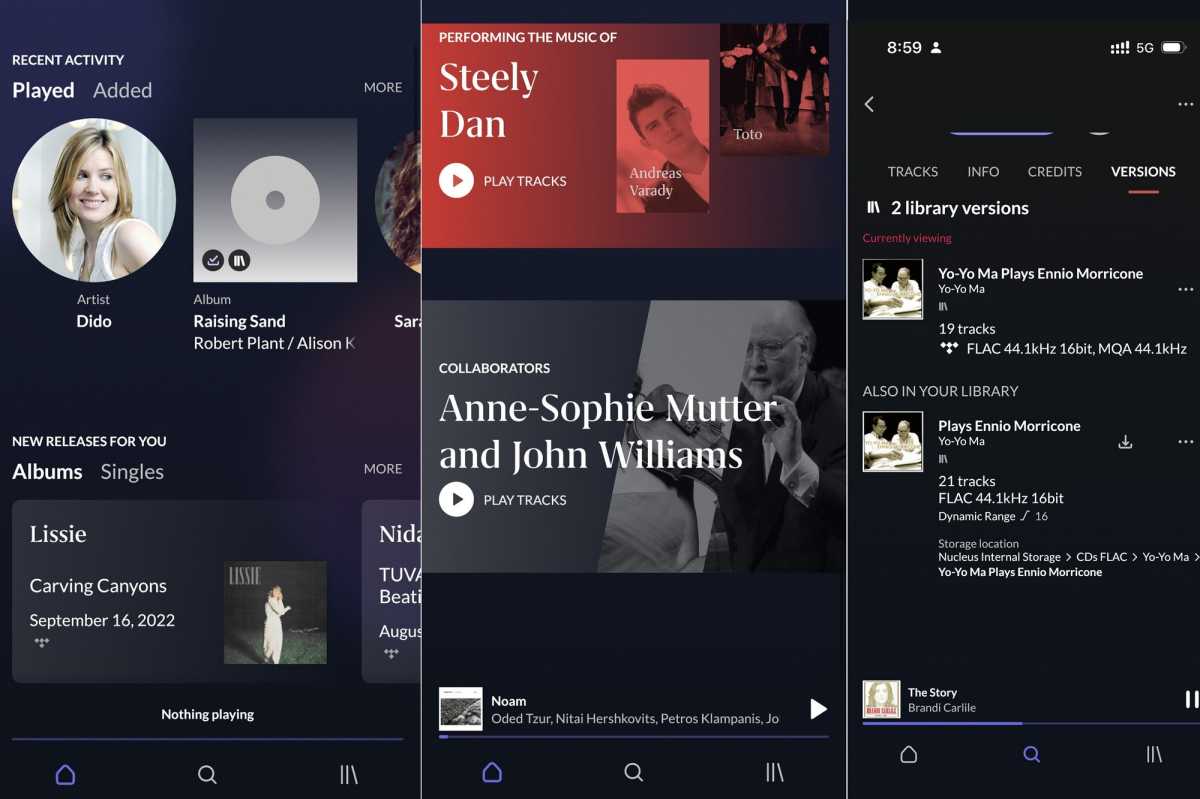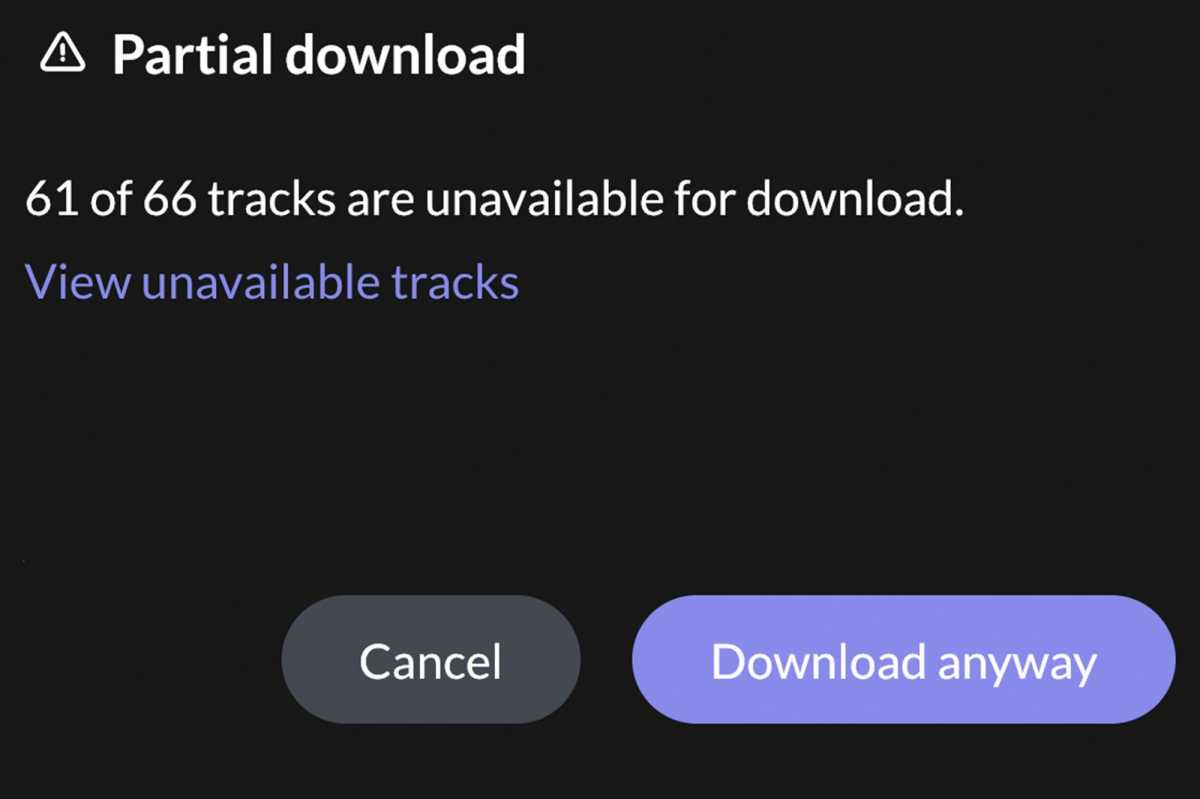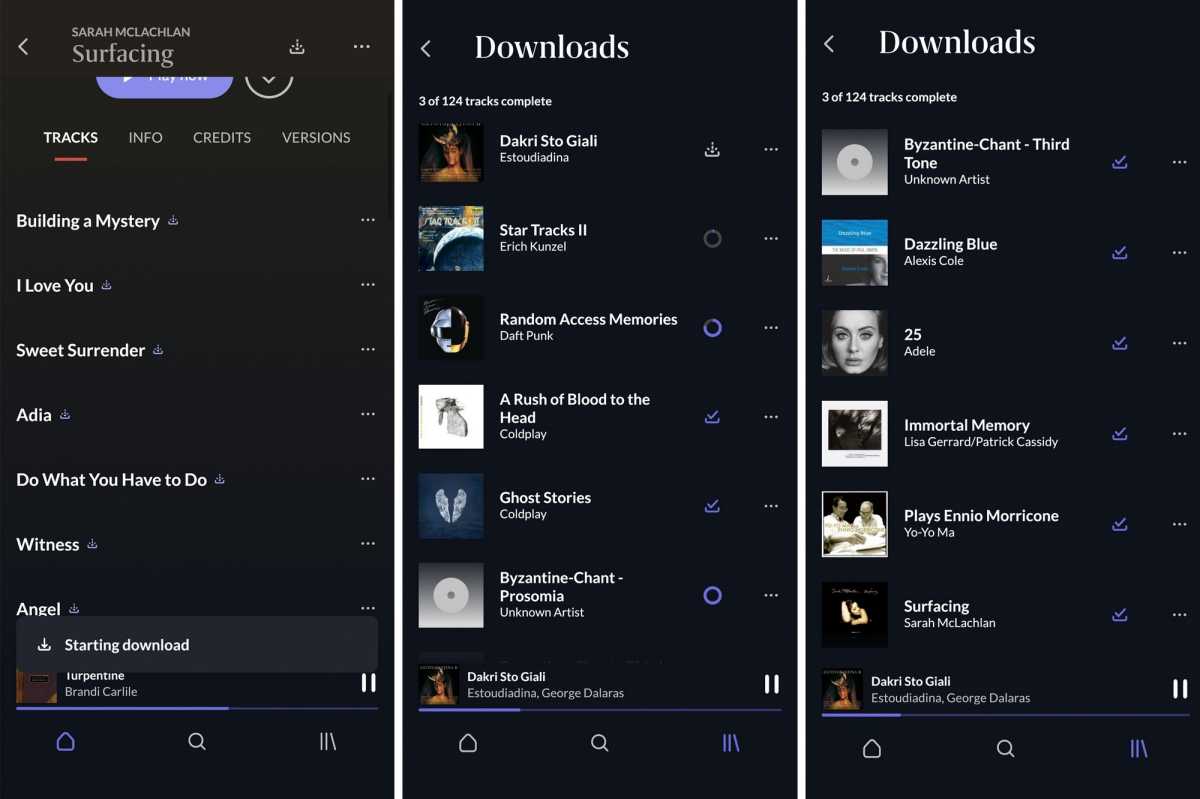At a glance
Expert’s Rating
Pros
- Your entire Roon music library and profiles on the go
- Outstanding streaming performance (with a strong internet connection)
- Ability to download purchased or ripped music for offline listening
- Slick, familiar Roon interface with full metadata and signal chain information
- Any actions performed on Roon ARC app sync to Roon Core
Cons
- Quirky behavior typical of first-generation products
- No Apple CarPlay or Android Auto support (still in development)
- Cannot download Tidal or Qobuz tracks for offline listening
- Potential for non-tech-savvy users to introduce serious security risks
Our Verdict
While we’ve identified a few shortcomings in this app, which is designed to complement the Roon server software, there’s nothing that dampens our enthusiasm for Roon itself. And we have every confidence that Roon ARC will soon become an essential complement to anyone’s Roon experience.
Price When Reviewed
Free with Roon; Roon itself costs $9.99 per month (pay $120 per year); $12.99 per month; or $699.99 for a lifetime license
Best Prices Today: Roon ARC
Seemingly every music-centric part of my day goes through Roon. Roon is the librarian, curator, and maestro for all my music. It’s the mainstay for my personal listening and reviews. It’s the heart of my multi-zone, multi-protocol, whole-home, streaming-music ecosystem. I trust Roon’s unparalleled metadata support, recommendations, and detailed liner notes to expand my engagement.
As essential as Roon is, it has had one Achilles’ heel: Portability. That all changes with Roon ARC.
Roon’s ARC mobile app, the subject of this review, empowers you to take your Roon musical experience on the go. It’s a solid overall product, with some typical first-version quirks and feature limitations. Read on to see just how well this first release will meet your expectations.
What is Roon 2.0?
If you don’t know what Roon is, I’m not sure I can describe it succinctly (you can read our in-depth Roon 1.8 review at the preceding link). Boiled down to its essence, Roon is a network music server. But it delivers so much more than that, including unrivaled metadata support and music aggregation from different network locations, devices, and streaming services into a single, seamless interface for multiple home users.
Roon gives me the power to play that music via any output (USB, HDMI, S/PDIF, and analog outputs) and stream to AirPlay, Chromecast, Sonos, and Roon-ready devices for a cross-platform, whole home, multi-zone, multi-user, music solution. It supports just about every major audio file format that matters; it has powerful DSP features; and details the fidelity at each step of my musical signal chain for optimal performance. This panoply of features is what’s endeared Roon to music lovers worldwide.
Roon’s ecosystem is comprised of what’s called the Roon Core (aka a hardware server) and audio devices that stream music from the Roon Core. You control the Roon Core via the Roon Remote app for iOS, Android, MacOS, or Windows.
What is Roon ARC?
Roon ARC instantly discovers and connects to your core. If you’re first connecting from your local network, ARC tells you whether or not your firewall is configured to allow for remote access to your Core.
Theo Nicolakis/Foundry
Roon ARC is a new iOS and Android-based app freely available as part of the Roon 2.0 update (Roon itself costs $120 per year or $700 for a lifetime subscription). There’s no acronym or meaning behind ARC, so don’t confuse it with HDMI Audio Return Channel or Anthem Room Correction.
Roon ARC is a technological leap forward for the entire Roon ecosystem. It unlocks your ability to access every album, artist, playlist, and history from your Roon Core, and to do that on the go. Put another way, Roon ARC finally allows you to savor the countless hours you’ve taken to curate your musical collection outside your home network via direct streaming or download via the internet.
The app introduces an updated user interface with functionality similar to the Roon Remote app—including individual user profiles. That means you’ll encounter a very small learning curve. You’ll find recently played tracks, playlists, and albums; instantly see recently added music; get recommendations of new releases, daily mixes, playlists, and genres suited to your musical tastes; and the power to search your entire music library. Just like the traditional app, you can do a deep dive into learning about your favorite artists, explore similar ones, or browse discographies. And yes, you can track the fidelity of the song you’re playing at each step of the signal chain to ensure it has exactly the fidelity you demand.

Roon ARC delivers the full power of Roon on the go, including your recent activity, playlists, recommendations, and different versions of the same music in your library.
Theo Nicolakis/Foundry
Unlike Roon Remote, which has you activate and configure each audio device, ARC pre-configures itself to your iOS or Android device capabilities. Roon ARC will also make available physical or wireless devices connected to your iOS or Android. For example, Roon ARC recognized my Apple Lightning-to-HDMI connector, so I could play tracks directly to a Denon X8500HA A/V receiver via HDMI.
Whatever you do on ARC gets synchronized back to your Roon Core. Your favorites, playlists, tags, artists, albums, genres, and listening times all get synched back. Roon’s powerful analytics engine (available on the Roon desktop app) displays all that data and analyzes your listening patterns for ongoing musical discovery.
How does Roon ARC work?
ARC’s operation is pretty simple. There’s an offline mode, so you can play ripped or purchased music dowloaded from the Core to your smart device. It also has an online mode, where ARC connects directly to your Core over the internet. Surprisingly, your home network does not require a static IP address or Dynamic DNS service for ARC to work.

Roon ARC has a similar array of features to the Roon Remote app, which makes using Roon ARC simple and easy.
Theo Nicolakis/Foundry
If you’re wondering how that’s possible, let me explain in a bit more detail: When you launch Roon ARC, it authenticates your username and password to Roon’s servers in the cloud. Once authenticated, those servers pass your Core’s IP address and listening port to ARC, which then connects to the Core. The Core then connects back to the Roon servers in the cloud to confirm that the Roon ARC app connecting to it is the exact same app that first authenticated. Roon says this triangular series of checks eliminates static IP address requirements and validates the identity of the ARC connection, so no one else can arbitrarily connect to your Roon Core from the internet.
Roon also says all the aforementioned networking connections should “just work” on most modern firewall routers designed for home use. If Roon ARC is not working as expected for you and you are not savvy with network security, I strongly recommend against arbitrarily changing any of your router’s or gateway’s firewall settings. You can end up exposing all devices in your home—not just your Roon Core—to malicious actors, leading to all sorts of serious problems.
Cybersecurity should be our collective concern. Roon says all connections that happen during the communication chain described are TLS encrypted, use hashed versions of your credentials, and employ the use of encrypted keys so that no nefarious actors can eavesdrop on connections (to a reasonable degree).
Allowing any connection from the internet can leave you vulnerable to potential threats, so Roon ARC users should strongly consider the following guidelines:
- Use a modern firewall router set to update its firmware and software automatically.
- Disable administrator (root) access to the firewall from the internet.
- Ensure you are running Roon on a modern operating system with auto-updates and firewall-enabled. While you might have older computers lying around, those older computers and unsupported operating systems are a security liability.
- Keep your Roon Core and apps updated to the latest software build.
- Ensure your Roon account has a hardened password and that the password is unique to Roon. Don’t use your Amazon or Netflix password as your Roon password, for example.
- Never put your Roon Core exposed directly to the internet, and certainly don’t experiment with unknown settings to get Roon to work.
- If Roon ARC isn’t working, seek reliable expert advice and understand the risks associated with network changes you might be making.
Current limitations of Roon ARC

I ran into a number of quirks with Roon ARC. The most frustrating issue was areas where I had a very poor cellular internet signal. ARC would get confused and time out. Downloaded tracks were affected, too. I had to go into offline mode to address the issue.
Theo Nicolakis/Foundry
The Roon team will be the first to say that ARC is intended to be a platform upon which it will develop the next generation of Roon features and functionality. It’s not a final product. Moreover, instead of investing precious development resources into features people might not want, the Roon team wanted to see the community’s priorities and then devote development resources to bring those feature requests to life. While Roon ARC delivers an authentic Roon experience, I found three major limitations during my testing.
First, there’s no Apple Car Play or Android Auto integration. To use Roon ARC in the car, I had to resort to my iPhone for control—not an ideal situation by any means. Nevertheless, my car’s volume controls, pause/play, next and reverse tracks all worked just fine with ARC. Enno Vandermeer, Roon’s CEO, confirmed with me that Apple Car Play and Android Auto are a priority, and we should see an updated version of ARC with these capabilities soon.

You can’t download Tidal or Qobuz tracks for offline listening. Roon ARC will let you know exactly how many tracks in your playlist can’t be downloaded with this error message.
Theo Nicolakis/Foundry
Second, if you’re a Tidal or Qobuz subscriber (like me), you can’t download or play tracks from either of those services in offline mode. Even if you’ve downloaded tracks from those services to your Roon Core, you’re limited to playing purchased or ripped music only while offline from your home network. I have less encouraging news here: There’s no technical hurdle for this malfunction, it’s a legal issue that you can blame on the music industry. Don’t hold your breath on a quick resolution; in fact, we might never see one.
Third, you still need Roon Remote for configuring devices, selecting zones, and grouping speakers. Roon says we’re a ways away before one app will rule them all.
Setting up Roon ARC
I set up and tested Roon ARC on an iPhone 12 Pro with iOS 15 and iPhone 14 Pro with iOS16 with my Roon Nucleus Core. My Nucleus server sits on a gigabit LAN network with a gigabit fiber broadband connection. Roon users should do fine with a traditional LAN and high-speed internet connection, but I would caution folks with DSL or cable broadband to check their upload speeds. Roon ARC will be pulling files from the Core up to the internet, so it’s your upload speed that will make all the difference.
Because I use professional networking equipment and have UPnP and similar auto-configuration technologies disabled, I needed to enable port forwarding in my firewall rules to get ARC to communicate with my Roon Nucleus Core. While Roon auto-configures a random network port by default, I could override the port assignment and specify any port I wanted via the Roon Remote app.
I decided to launch Roon ARC while connected to my local network (and recommend you do the same for first-time connections), and in a matter of moments ARC found my Roon Core, asked me which user I was, and well… voila! That was it.

Roon ARC allows you to download your ripped and purchased music for offline listening.
Theo Nicolakis/Foundry
With a strong Wi-Fi or cellular data connection, streaming was nearly instantaneous. That’s an impressive statement considering I’m connecting to a home server, not some optimized, global, content-delivery network.
The app was responsive and sound quality in its default settings was excellent. ARC gave me the ability to throttle my streaming quality and even FLAC and DSD files played on my iPhone. Roon ARC performed flawlessly in these contexts.
Downloading files for offline listening had the limitation I mentioned previously, so Tidal tracks in my Roon library were off-limits. Nevertheless, ALAC, FLAC, DSD, ripped, and purchased files downloaded and played well. This is a real game-changer for taking your library on-the-go with full fidelity.
Unfortunately, things weren’t all roses. I encountered two maddening bugs during my testing. The first occurred in specific geographic areas where I had either a weak cellular signal (such as the bowels of Penn Station in NYC), or when my Wi-Fi was transitioning to a weak cellular signal. If I launched ARC, it would have problems opening and playing material of any kind—streamed or downloaded. It was as though the app didn’t know whether to go into offline or streaming mode.

Roon ARC lets you do a deep dive into every part of the signal chain, so you can track your musical fidelity at every point. Roon gives you anexplanation of each part of the signal chain.
Theo Nicolakis/Foundry
If I did get the app to launch, it would just spin and spin, finally timing out. What was most peculiar about these instances is that if I tried to play music files I had downloaded to my iPhone, ARC would still spin and timeout. Putting my phone into airplane mode jolted the app into offline mode, and it then played downloaded content immediately. My expectation is that I should be able to play music downloaded to my phone regardless of my connection status.
Finally, for those who might be wondering if ARC might have alternative connection methods, the answer is yes. I successfully tested Roon ARC by creating a point-to-point VPN between my iPhone and firewall (with port forwarding off). ARC worked just fine, and this is an alternative option should you prefer that connection method.
Roon ARC is a splendid work in progress
Roon enthusiasts rejoice! It’s finally happened. With Roon ARC, you can take your entire Roon library with you anywhere there’s an internet connection. More importantly, Roon ARC delivers your entire music library with the look, feel, power, and ease of everything Roon.
While ARC is the future of the Roon, there are some glaring limitations in this first release that limit our overall rating. There’s no Apple CarPlay or Android Auto (yet); you can’t download Tidal or Qobuz music for offline listening; and there are some functional quirks typical of a first-release product.
All that aside, Roon ARC is an unexpected gift to the audiophile world. ARC is a revolution for Roon’s ecosystem. We will circle back to this review and revisit our score as its limitations are overcome.

